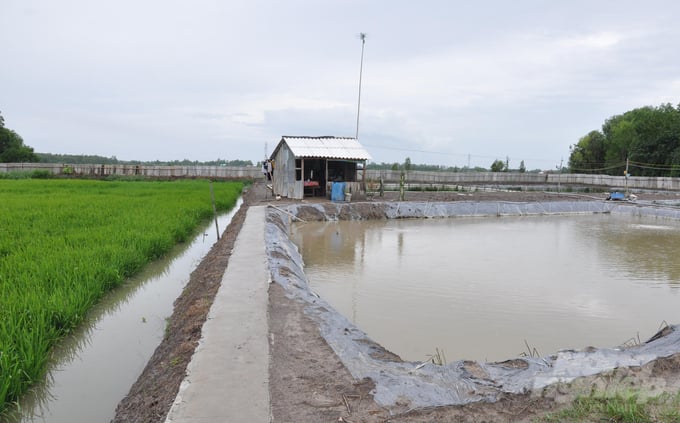November 25, 2025 | 16:26 GMT +7
November 25, 2025 | 16:26 GMT +7
Hotline: 0913.378.918
November 25, 2025 | 16:26 GMT +7
Hotline: 0913.378.918

Rice cultivation and fish farming protect the green, clean, and safe living environment. Photo: Huu Duc.
Numerous firms consider the green economy to be a critical development trend. According to Le Truong Son, Deputy General Director of the Ho Chi Minh City Union of Trade Cooperatives (Saigon Coop), the unit is supporting a program to build sustainable raw material areas in the Mekong Delta and Southeast region. The company makes measures to go further into the transformation and creation of appropriate product value chains, so assisting in the change of farmers' mindsets about agricultural economies.
Saigon Co.op now operates a supermarket chain that spans several cities and villages around the country. 90% of the items in the system chain are manufactured in the country, and the supply ranges from agricultural to aquatic products. Ho Chi Minh City recently tasked Saigon Co.op with deploying activities in collaboration with the Department of Industry and Trade of provinces and cities in the Mekong Delta, Southeast region, and Central Highlands to implement the "Sustainable Material Area Development Program," which includes 800 projects associated with business partners, cooperatives, and farmer cooperative groups.
Green growth and sustainable development must include commercialization, particularly distribution centers and retails, as well as the creation of lines for enterprises to approach consumers with green and clean products. In 2023, Saigon Co.op will collaborate with the Business Association of High-Quality Vietnamese Goods to launch the Green Table Program, which aims to raise awareness and standard practices among consumer goods manufacturers that distribute their products through Saigon Co.op. The Green Table Program is set to debut in April of this year.

Planting cantaloupe under control creates safe and quality products. Photo: Huu Duc.
Duy Tan Recycle is one of those investing in green economy development with an emphasis on production on environmental protection. Moving from a company that specialized in the manufacture of plastic items to a whole new field: recycled plastic. Mr. Le Anh, Duy Tan Recycle's Sustainable Development Director, stated that the manufacturing process, which included collecting plastic bottles, sorting, cleaning, and generating recycled plastic pellets, satisfied 15 specifications for export to the US market.
Making a mark for a clean and beautiful green environment, in 2022 Duy Tan Recycle collected and recycled more than 1.3 billion plastic bottles. Duy Tan Recycle facility now has a processing capacity of 30,000 tons of PET plastic per year and wants to enhance it to 60,000 tons per year. Pham Chi Lan, Vice President of the Business Association of High-Quality Vietnamese Products said, some nations have paid attention to the new United Nations resolution on sustainable development, which includes a green standard that does not hurt other elements while benefiting the underprivileged. Therefore, Vinh Hoan Company (Dong Thap) has clearly proved not just compliance with requirements but also the practice of circular economy. The circular economy is a part of the green economy, and it is a green method of demonstrating the value of your products and services.
Green standards, according to Lan, are required for agricultural products aimed at export markets such as the EU, the US, Japan, and even China. They will not buy if they do not match the needs of green standards, thus the production may be quite redundant. Certain agricultural goods in our nation have the most competitive advantages, desire to add value rather than sell raw products, sell cheaply compared to some countries in the area in the same sector, and must comply with requirements. Green and extensively tested across the value chain.
The Ministry of Agriculture and Rural Development (MARD) has adopted an action plan to achieve the National Green Growth Plan from 2021 to 2030.
The plan's mission is to outline goals, targets, and solutions for putting the strategy and national action plan for green growth into action.
The ministry will work to develop the agricultural sector in an ecological, organic, circular, and low-carbon direction in order to improve growth quality, added value, competitiveness, and sustainable development while reducing pollution in agricultural production and rural areas and promoting energy efficiency in order to achieve carbon neutrality by 2050.
To secure resources for green growth, it will mobilize social resources, particularly those from enterprises, while also requesting financial assistance and technology transfer via international cooperation initiatives.
Translated by Linh Linh
/2025/11/25/0045-1-135246_13.jpg)
(VAN) Ca Mau is researching a model of sea-encroaching embankments combined with viaducts and logistics service zones, aiming both to prevent erosion and create land funds for marine economic development.

(VAN) The information was shared at the seminar 'Urban Agriculture - Solutions for Developing Green Spaces,' organized by the Kinh te & Do thi Newspaper and the Biotechnology Center of Ho Chi Minh City.
/2025/11/19/4141-2-132831_216.jpg)
(VAN) One of Japfa's outstanding solutions is implementing digital transformation and artificial intelligence (AI) to optimize operations, enhance productivity, and advance sustainable development.
/2025/11/19/4847-1-093540_448.jpg)
(VAN) The Gia Lai Provincial People’s Committee had a working session with the delegation of the U.S. Department of Agriculture, the State of Idaho, and representatives of the State's leading enterprises.

(VAN) Ca Mau has a sufficient foundation to become a strong regional aquaculture center, where production integrates the economy, the environment, and the lives of the people.

(VAN) SEIKI Group envisions itself as a pioneer in the ‘dual transformation’ of digital technology and green industry, standing alongside the Government and Vietnamese businesses in their pursuit of sustainable development.

(VAN) The VNGEONET network affirms Viet Nam's progress in mastering digital space, providing a precise positioning data platform to serve socioeconomic development.